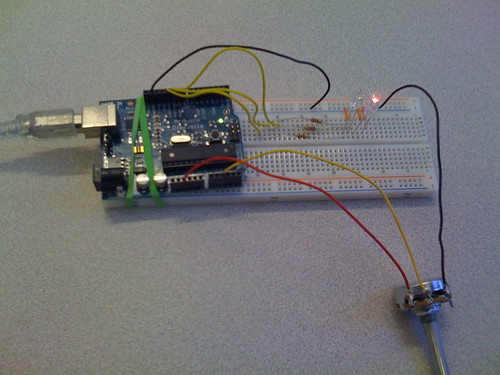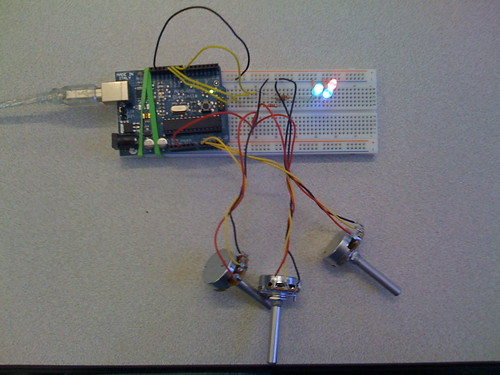Assignment: Sensing: Potentiometers
Collaborators:
Assignment: Sensing: Potentiometers
Collaborators: eknight
Author: Erin Knight
Description:
This lab was my first experience with soldering! Heck, it was my first experience with stripping wire! I have to admit, I was pretty darn good at it ;). We soldered three wires to a potentiometer so that we could use the potentiometer to control our LEDs in the following ways:
Then I got to strip wires and solder again (woo hoo!) to get set up to use multiple pots to control my LEDs (I did both of the options):
Then I tried my own fun with pots:
I used one pot to create a transition of blinking LEDs - with the rate of the blinking controlled by the pot. So it would blink red, then blue, then green, for example and as I turned the pot, the chasing rainbow would move through the colors more quickly. See code below.
Pictures of my board:


Code:
Using 1 Pot to Control the Brightness of 1 LED:
/*
* one pot fades one led
* modified version of AnalogInput
* by DojoDave <http://www.0j0.org>
* http://www.arduino.cc/en/Tutorial/AnalogInput
*/
int potPin = 2; // select the input pin for the potentiometer
int ledPin = 9; // select the pin for the LED
int val = 0; // variable to store the value coming from the sensor
void setup() {
Serial.begin(9600);
}
void loop() {
val = analogRead(potPin); // read the value from the sensor, between 0 - 1024
Serial.println(val);
analogWrite(ledPin, val/4); // analogWrite can be between 0-255
}
_______________________________________________
Using 1 Pot to Control the Blinking Rate of 1 LED:
/*
* AnalogInput
* by DojoDave <http://www.0j0.org>
*
* Turns on and off a light emitting diode(LED) connected to digital
* pin 13. The amount of time the LED will be on and off depends on
* the value obtained by analogRead(). In the easiest case we connect
* a potentiometer to analog pin 2.
*
* http://www.arduino.cc/en/Tutorial/AnalogInput
*/
int potPin = 2; // select the input pin for the potentiometer
int ledPin = 13; // select the pin for the LED
int val = 0; // variable to store the value coming from the sensor
void setup() {
pinMode(ledPin, OUTPUT); // declare the ledPin as an OUTPUT
}
void loop() {
val = analogRead(potPin); // read the value from the sensor
digitalWrite(ledPin, HIGH); // turn the ledPin on
delay(val); // stop the program for some time
digitalWrite(ledPin, LOW); // turn the ledPin off
delay(val); // stop the program for some time
}
____________________________________________________
Using 2 Pots to Control Brightness/Blinking of 3 LEDs:
/*
* one pot dims, the other pot changes the blinking rate
* modification of the following
* http://www.arduino.cc/en/Tutorial/AnalogInput
*/
int pot1Pin = 0; // select the input pin for the potentiometer 1
int pot2Pin = 1; // select the input pin for the potentiometer 2
int pot1Val = 0; // variable to store the value coming from pot 1
int pot2Val = 0; // variable to store the value coming from pot 2
int led1Pin = 9; // select the pin for the LED 1
int led2Pin = 11; // select the pin for the LED 2
void setup() {
pinMode(led1Pin, OUTPUT); // declare the led1Pin as an OUTPUT
pinMode(led2Pin, OUTPUT); // declare the led2Pin as an OUTPUT
}
void loop() {
pot1Val = analogRead(pot1Pin); // read the value from pot 1, between 0 - 1024, for dimming
pot2Val = analogRead(pot2Pin); // read the value from pot 2, between 0 - 1024, for blinking
analogWrite(led2Pin, pot1Val/4); // dim LED to value from pot1
delay(pot2Val); // stop the program for some time, meaning, LED is on for this time
analogWrite(led2Pin, 0); // dim LED to completely dark (zero)
delay(pot2Val); // stop the program for some time, meaning, LED is OFF for this time
}
____________________________________________________
Using 3 Pots to Control Brightness of 3 LEDs:
// Analog pin settings
int aIn = 0; // Potentiometers connected to analog pins 0, 1, and 2
int bIn = 1; // (Connect power to 5V and ground to analog ground)
int cIn = 2;
// Digital pin settings
int aOut = 9; // LEDs connected to digital pins 9, 10 and 11
int bOut = 10; // (Connect cathodes to digital ground)
int cOut = 11;
// Values
int aVal = 0; // Variables to store the input from the potentiometers
int bVal = 0;
int cVal = 0;
// Variables for comparing values between loops
int i = 0; // Loop counter
int wait = (1000); // Delay between most recent pot adjustment and output
int checkSum = 0; // Aggregate pot values
int prevCheckSum = 0;
int sens = 3; // Sensitivity theshold, to prevent small changes in
// pot values from triggering false reporting
// FLAGS
int PRINT = 1; // Set to 1 to output values
int DEBUG = 1; // Set to 1 to turn on debugging output
void setup()
{
pinMode(aOut, OUTPUT); // sets the digital pins as output
pinMode(bOut, OUTPUT);
pinMode(cOut, OUTPUT);
Serial.begin(9600); // Open serial communication for reporting
}
void loop()
{
i += 1; // Count loop
aVal = analogRead(aIn) / 4; // read input pins, convert to 0-255 scale
bVal = analogRead(bIn) / 4;
cVal = analogRead(cIn) / 4;
analogWrite(aOut, aVal); // Send new values to LEDs
analogWrite(bOut, bVal);
analogWrite(cOut, cVal);
if (i % wait == 0) // If enough time has passed...
{
checkSum = aVal+bVal+cVal; // ...add up the 3 values.
if ( abs(checkSum - prevCheckSum) > sens ) // If old and new values differ
// above sensitivity threshold
{
if (PRINT) // ...and if the PRINT flag is set...
{
Serial.print("A: "); // ...then print the values.
Serial.print(aVal);
Serial.print("\t");
Serial.print("B: ");
Serial.print(bVal);
Serial.print("\t");
Serial.print("C: ");
Serial.println(cVal);
PRINT = 0;
}
}
else
{
PRINT = 1; // Re-set the flag
}
prevCheckSum = checkSum; // Update the values
if (DEBUG) // If we want debugging output as well...
{
Serial.print(checkSum);
Serial.print("<=>");
Serial.print(prevCheckSum);
Serial.print("\tPrint: ");
Serial.println(PRINT);
}
}
}
My Special Code - The Chasing Rainbow (1 pot, 3 LEDs):
/*
Uses one pot to light 3 LEDs in succession - the pot determines the rate of the progression.
*/
int potPin = 0; // select the input pin for the potentiometer
int ledPin1 = 9; // select the pin for the LED1
int ledPin2 = 10; // select the pin for the LED2
int ledPin3 = 11; // select the pin for the LED3
int val = 0; // variable to store the value coming from the sensor
void setup() {
pinMode(ledPin1, OUTPUT); // declare the ledPin1 as an OUTPUT
pinMode(ledPin2, OUTPUT); // declare the ledPin2 as an OUTPUT
pinMode(ledPin3, OUTPUT); // declare the ledPin as an OUTPUT
}
void loop() {
val = analogRead(potPin); // read the value from the sensor
digitalWrite(ledPin1, HIGH); // turn the ledPin1 on
delay(val); // stop the program for some time
digitalWrite(ledPin1, LOW); // turn the ledPin1 off
delay(val); // stop the program for some time
digitalWrite(ledPin2, HIGH); // turn the ledPin2 on
delay(val); // stop the program for some time
digitalWrite(ledPin2, LOW); // turn the ledPin2 off
delay(val); // stop the program for some time
digitalWrite(ledPin3, HIGH); // turn the ledPin3 on
delay(val); // stop the program for some time
digitalWrite(ledPin3, LOW); // turn the ledPin3 off
delay(val); // stop the program for some time
}